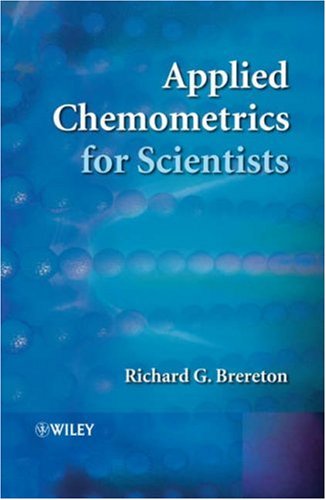

Most ebook files are in PDF format, so you can easily read them using various software such as Foxit Reader or directly on the Google Chrome browser.
Some ebook files are released by publishers in other formats such as .awz, .mobi, .epub, .fb2, etc. You may need to install specific software to read these formats on mobile/PC, such as Calibre.
Please read the tutorial at this link. https://ebooknice.com/page/post?id=faq
We offer FREE conversion to the popular formats you request; however, this may take some time. Therefore, right after payment, please email us, and we will try to provide the service as quickly as possible.
For some exceptional file formats or broken links (if any), please refrain from opening any disputes. Instead, email us first, and we will try to assist within a maximum of 6 hours.
EbookNice Team

Status:
Available4.3
31 reviews
ISBN 10: 0470016868
ISBN 13: 9780470016862
Author: Richard G Brereton
The book introduces most of the basic tools of chemometrics including experimental design, signal analysis, statistical methods for analytical chemistry and multivariate methods. It then discusses a number of important applications including food chemistry, biological pattern recognition, reaction monitoring, optimisation of processes, medical applications. The book arises from a series of short articles that have been developed over four years on Chemweb (www.chemweb.com).
1 Introduction.
1.1 Development of Chemometrics.
1.2 Application Areas.
1.3 How to Use this Book.
1.4 Literature and Other Sources of Information.
References.
2 Experimental Design.
2.1 Why Design Experiments in Chemistry?
2.2 Degrees of Freedom and Sources of Error.
2.3 Analysis of Variance and Interpretation of Errors.
2.4 Matrices, Vectors and the Pseudoinverse.
2.5 Design Matrices.
2.6 Factorial Designs.
2.7 An Example of a Factorial Design.
2.8 Fractional Factorial Designs.
2.9 Plackett–Burman and Taguchi Designs.
2.10 The Application of a Plackett–Burman Design to the Screening of Factors Influencing a Chemical Reaction.
2.11 Central Composite Designs.
2.12 Mixture Designs.
2.13 A Four Component Mixture Design Used to Study Blending of Olive Oils.
2.14 Simplex Optimization.
2.15 Leverage and Confidence in Models.
2.16 Designs for Multivariate Calibration.
References.
3 Statistical Concepts.
3.1 Statistics for Chemists.
3.2 Errors.
3.3 Describing Data.
3.4 The Normal Distribution.
3.5 Is a Distribution Normal?
3.6 Hypothesis Tests.
3.7 Comparison of Means: the t-Test.
3.8 F-Test for Comparison of Variances.
3.9 Confidence in Linear Regression.
3.10 More about Confidence.
3.11 Consequences of Outliers and How to Deal with Them.
3.12 Detection of Outliers.
3.13 Shewhart Charts.
3.14 More about Control Charts.
References.
4 Sequential Methods.
4.1 Sequential Data.
4.2 Correlograms.
4.3 Linear Smoothing Functions and Filters.
4.4 Fourier Transforms.
4.5 Maximum Entropy and Bayesian Methods.
4.6 Fourier Filters.
4.7 Peakshapes in Chromatography and Spectroscopy.
4.8 Derivatives in Spectroscopy and Chromatography.
4.9 Wavelets.
References.
5 Pattern Recognition.
5.1 Introduction.
5.2 Principal Components Analysis.
5.3 Graphical Representation of Scores and Loadings.
5.4 Comparing Multivariate Patterns.
5.5 Preprocessing.
5.6 Unsupervised Pattern Recognition: Cluster Analysis.
5.7 Supervised Pattern Recognition.
5.8 Statistical Classification Techniques.
5.9 K Nearest Neighbour Method.
5.10 How Many Components Characterize a Dataset?
5.11 Multiway Pattern Recognition.
References.
6 Calibration.
6.1 Introduction.
6.2 Univariate Calibration.
6.3 Multivariate Calibration and the Spectroscopy of Mixtures.
6.4 Multiple Linear Regression.
6.5 Principal Components Regression.
6.6 Partial Least Squares.
6.7 How Good is the Calibration and What is the Most Appropriate Model?
6.8 Multiway Calibration.
References.
7 Coupled Chromatography.
7.1 Introduction.
7.2 Preparing the Data.
7.3 Chemical Composition of Sequential Data.
7.4 Univariate Purity Curves.
7.5 Similarity Based Methods.
7.6 Evolving and Window Factor Analysis.
7.7 Derivative Based Methods.
7.8 Deconvolution of Evolutionary Signals.
7.9 Noniterative Methods for Resolution.
7.10 Iterative Methods for Resolution.
8 Equilibria, Reactions and Process Analytics.
8.1 The Study of Equilibria using Spectroscopy.
8.2 Spectroscopic Monitoring of Reactions.
8.3 Kinetics and Multivariate Models for the Quantitative Study of Reactions
8.4 Developments in the Analysis of Reactions using On-line Spectroscopy.
8.5 The Process Analytical Technology Initiative.
References.
9 Improving Yields and Processes Using Experimental Designs.
9.1 Introduction.
9.2 Use of Statistical Designs for Improving the Performance of Synthetic Reactions.
9.3 Screening for Factors that Influence the Performance of a Reaction.
9.4 Optimizing the Process Variables.
9.5 Handling Mixture Variables using Simplex Designs.
9.6 More about Mixture Variables.
10 Biological and Medical Applications of Chemometrics.
10.1 Introduction.
10.2 Taxonomy.
10.3 Discrimination.
10.4 Mahalanobis Distance.
10.5 Bayesian Methods and Contingency Tables.
10.6 Support Vector Machines.
10.7 Discriminant Partial Least Squares.
10.8 Micro-organisms.
10.9 Medical Diagnosis using Spectroscopy.
10.10 Metabolomics using Coupled Chromatography and Nuclear Magnetic Resonance.
References.
11 Biological Macromolecules.
11.1 Introduction.
11.2 Sequence Alignment and Scoring Matches.
11.3 Sequence Similarity.
11.4 Tree Diagrams.
11.5 Phylogenetic Trees.
References.
12 Multivariate Image Analysis.
12.1 Introduction.
12.2 Scaling Images.
12.3 Filtering and Smoothing the Image.
12.4 Principal Components for the Enhancement of Images.
12.5 Regression of Images.
12.6 Alternating Least Squares as Employed in Image Analysis.
12.7 Multiway Methods In Image Analysis.
References.
13 Food.
13.1 Introduction.
13.2 How to Determine the Origin of a Food Product using Chromatography.
13.3 Near Infrared Spectroscopy.
13.4 Other Information.
13.5 Sensory Analysis: Linking Composition to Properties.
13.6 Varimax Rotation.
13.7 Calibrating Sensory Descriptors to Composition.
References.
applied chemometrics for scientists
applied chemometrics for scientists pdf
applied chemometrics
applied chemometrics inc
chemometrics books
chemometrics a textbook
chemometrics book
Tags: Richard G Brereton, Chemometrics, Scientists